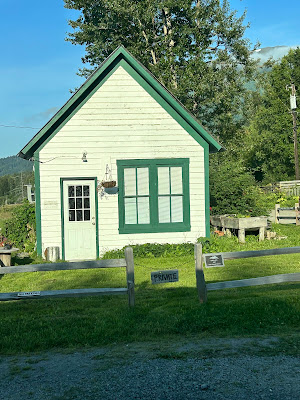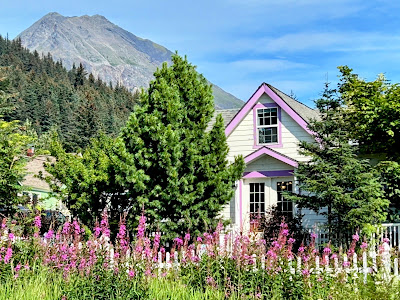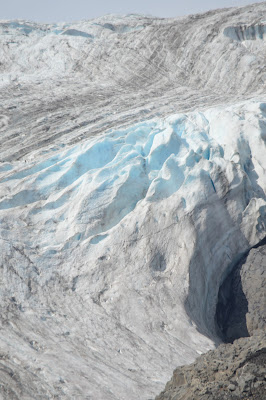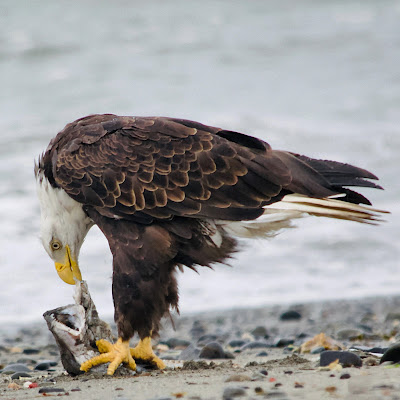August in Alaska can be rainy, but we were anxious to use our motorhome, so we left the rain in Talkeetna and drove to the Kenai peninsula. It had been several years since we'd been South of Anchorage, so this seemed the perfect time to do go.
 |
| The small town of Hope was our first stop. It can be seen on the map beneath the letter A in Anchorage. |
One road leads south of Anchorage, the Seward Highway. This heavily traveled roadway winds along the Turnagain Arm of Cook Inlet and beneath snowy Chugach Mountain peaks. The town of Hope, similar to Talkeetna, is at the end of a 17 mile spur road. Although the population of Hope is said to be about 100 residents, it's a very popular summer destination. This particular weekend, music filled the air, people strolled the streets and a celebration of some sort was happening. Hope's scenic beauty combined with its laid back vibe makes it hard to resist. Our hope, pardon the pun, of camping in Hope near Resurrection Creek was quickly squelched. Fishermen lined the creek banks and all campsites were taken either by them or those partying in the street.
 |
| The Seaview Cafe, recently sold and renamed the Hope Cafe, is often the site of music in Hope. |
 |
| I love the white and green theme that plays out in Hope. |
 |
| Take note of the paper ballot! |
Two people stand on the marsh in Hope looking across the Turnagain Arm.
It's only 40 plus miles from Hope to Moose Pass, so we continued on certain of a camping spot there. Moose Pass claims a population of under 300 people and lies on the shore of Upper Trail Lake, surrounded by towering peaks. Unfortunately, a steady stream of traffic passes through this small village headed to Seward. We were happy to leave this line of traffic and pull down the short dirt road leading to the ballfield. I assume this once was a ballfield, but now, through word of mouth, it's become a popular free lakeside camping area.
 |
| A small boat breaks the glassy surface of Trail Lake. |
No one ever parked beside us which was an added bonus. It wasn't until I looked at my emailed receipt that I noticed the privilege of booking through a human had cost us an additional $10. Definitely money well spent!
Seward is a bustling town and harbor with many shops and tourist attractions including fjord tours and the SeaLife Center. www.alaskasealife.org. We have enjoyed each of these in the past so we were content to relax and feel sun on our faces while listening to the waves crash.
However, I did leave the shore to take a walk through some of historic Seward. I’ve always loved the small cottages and bungalows that line Seward's side streets. Historic in Alaska refers to the 1900's which for a New Englander seems almost modern! This cottage caught my eye.
 |
| The trim and fireweed match in color! |
 |
| Circa 1916 |
 |
| St Peter’s Episcopal Church circa1905 |
On July 4th, Seward celebrates the Mount Marathon Race. On this day racers scramble 3022 feet to the summit of Mt Marathon and slide back down on a very steep trail easily seen on the mountain’s face.
We spent six days on the Kenai Peninsula. Each one filled with ocean views minus seeing the volcanos that dot the far shore of Cook Inlet.
We finished our trip with a return visit to the Norman Lowell Gallery. We learned that the gallery, housing Mr. Lowell’s life work, is now a nonprofit ensuring that all those who wish to view his art will have access to it.
Norman Lowell, his wife Libby and infant child arrived in Anchor Point in 1958 from Iowa before the existence of the Seward Highway. By way of the Homestead Act, they acquired 160 acres and there they built a small cabin on a bluff overlooking Anchor Creek. Norman dedicated his life to teaching art and capturing with his brush strokes Alaska’s unique beauty. We had the pleasure of meeting this artist in 2008 many years before he became legally blind from Glaucoma thus ending his artwork.
This photo taken when meeting the artist in 2008.
I wished in 2008 to be able to afford one of his paintings, some of which were selling for $3,000. Now, his art can sell for as much $100k.
We were told that today at 96 Norman lives in assisted living in Homer, but Libby still lives in their house on the homestead. I feel grateful to have met this artist who is often described as “Alaska’s artist”. There’s no doubt his brushes were guided by his love for Alaska.
His large canvases, some as big as 9’ by 14’ envelope the viewer.





















No comments:
Post a Comment